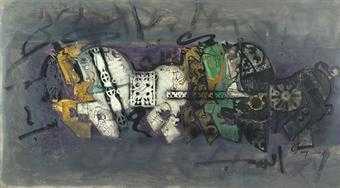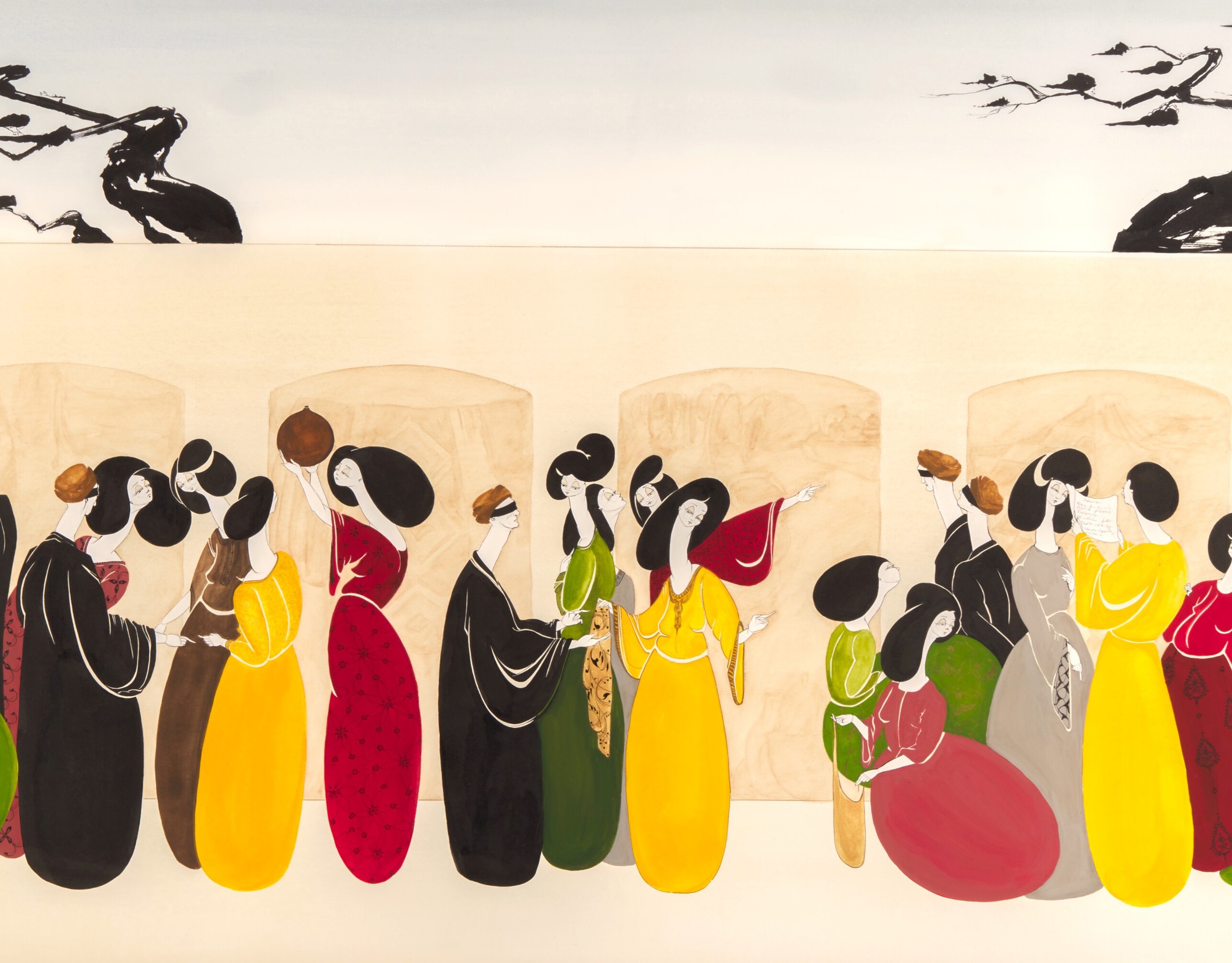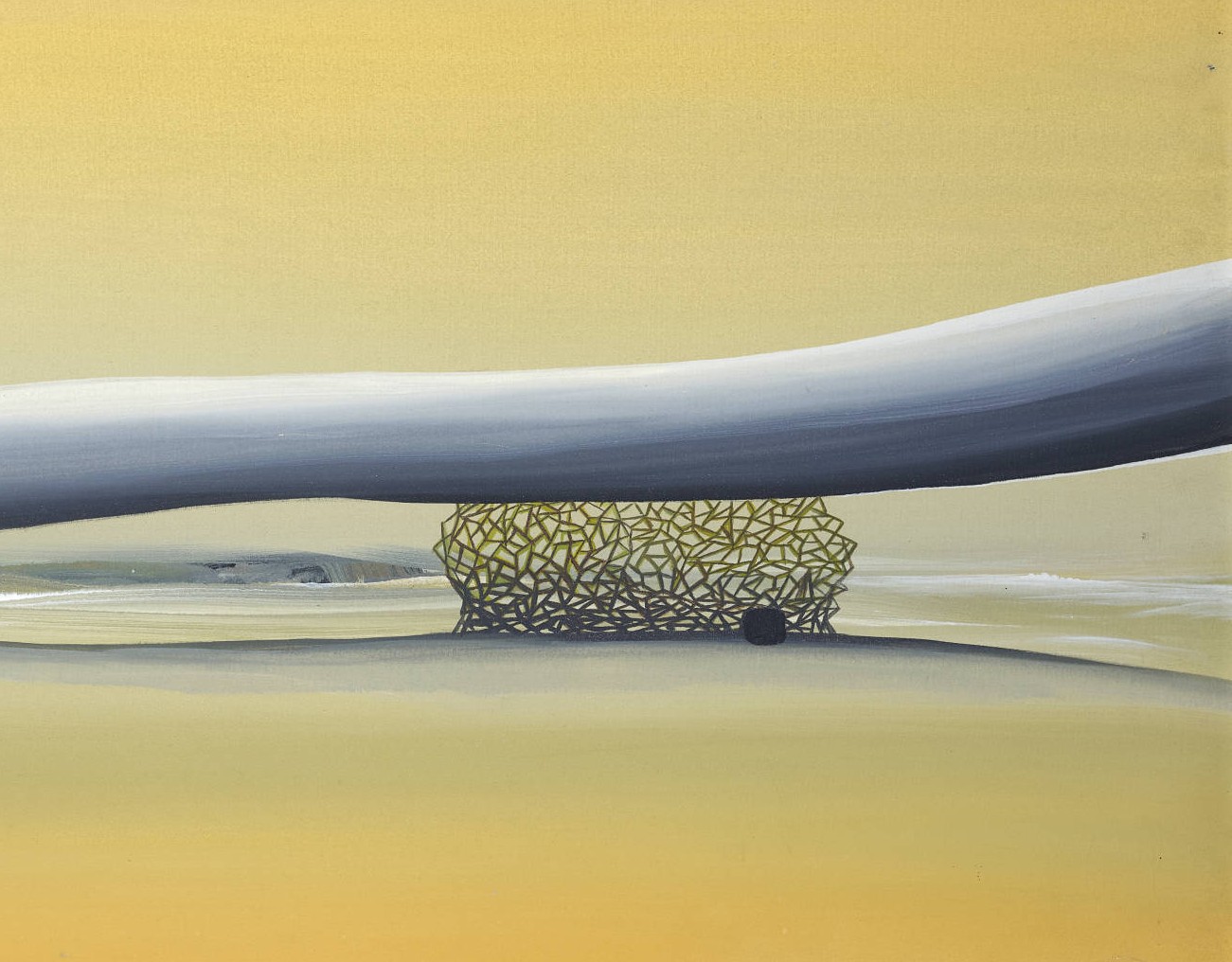About Nasser Ovissi
Nasser Ovissi, a multifaceted artist renowned for his contributions to the neo-traditionalist and Saqakhaneh movements in Iran, embarked on his artistic journey after earning a degree in political science from the University of Tehran in 1956. His quest for artistic mastery led him to Rome, where he delved into various disciplines including painting, pottery, goldsmithing, and lithography, ultimately receiving an art diploma.
Ovissi's talent was quickly recognized, earning him the esteemed Work View of Tehran Painters award in his debut exhibition in 1956. Over the years, he showcased his works in numerous solo and group exhibitions across Iran, earning accolades such as recognition at the third and fourth Tehran Biennials in 1962 and 1964. His tenure at the State Department and extensive stays in Rome and Madrid facilitated his engagement with global art communities, leading to exhibitions of his works in countries like Brazil, America, Italy, France, and Japan, alongside celebrated artists such as Picasso, Chagall, and Dolly. Notably, Ovissi received the High Prize at the International Art Exhibition of Monaco in 1974, solidifying his status as a luminary of modern Iranian art. His influence extended beyond borders, meriting inclusion in prestigious art references like the Thirteen-Volume French Encyclopedia of Art (Benzite) and "In Answer to Art," a seminal text in American art history education, which dedicates a page to Ovissi's engravings for Khayyam's poems.
In the early stages of his career, Ovissi gravitated towards Impressionism before embracing the indigenous aesthetic elements of Iranian art. By the early 1960s, he endeavored to meld these elements with Western painting techniques, aligning himself with the Saqakhaneh movement. His artistic vision drew inspiration from the rich tradition of Timurid and Seljuk tiles and pottery, as well as the opulent artistry of the Qajar period. Notably, Ovissi integrated the rhythmic grace of calligraphy into his modern paintings, forging a unique aesthetic synthesis. Esteemed art critic Julio Carlo Argan lauds Ovissi's works as straddling the realms of poetry and painting, with a style imbued with calligraphic rhythms.
Throughout his oeuvre, recurring motifs such as horses and women serve as vehicles for Ovissi's subjective and abstract exploration of Iranian painting traditions. In an interview with Javad Mojabi, he articulates his affinity for subjectivism and abstraction, challenging Western realist norms. Ovissi's artworks have garnered widespread acclaim within Iranian artistic and literary circles. Nader Naderpour lauds him as "the illustrator of adult dreams beyond our childhood stories," while Ehsan Yarshater hails him as "the true heir of beauty in the style of the golden age of Iranian art." Javad Mojabi celebrates Ovissi's ability to transcend temporal and spatial constraints, capturing the essence of Iranian humanistic romantic mysticism.
The Most Expensive Artwork
At Auctions
First Attendance
24 May 2006
# Attendance
148
# Artworks
222
Average Realized Price
12,125 USD
Average Min Estimate
8,249 USD
Average Max Estimate
11,672 USD
Sell-through Rate
50%
Average Growth of Artwork Worth
29.238%
Timeline
Arab, Iranian & Turkish Art / Modern & Contemporary Middle Eastern Art | N°22 auction
15 December
Deck the Walls: Original Art & Ltd. Editions auction
11 December
October Estate auction
9 October
CHARSOO- Part 2 exhibition
3 October
The 24th Tehran - Contemporary Iranian Art auction
3 October
Charsoo exhibition
5 September
Middle East / 20th Century Art / n°21 auction
6 July
Summer Finds: Fine Art & Antiques auction
25 June
The 23rd Tehran - Modern and Contemporary Iranian Art auction
22 May
Modern & Contemporary Art auction
20 May
Contemporary Art & Decorative Arts auction
13 May
Modern and Contemporary Middle East auction
1 May
Contemporary Paintings and Sculpters, Lithographs, Photographs auction
26 April
April Art Cornucopia auction
25 April
In white exhibition
18 April
Shadow exhibition
18 April
Shifting Gazes: Women Through Middle Eastern Eyes exhibition
15 April
Nowruznegar 2 exhibition
7 March
The 22nd Tehran - Modern, Classic and Traditional Iranian Art auction
14 February
February Art Cornucopia auction
14 February
Modern and Contemporary Collector exhibition
7 February
The 13th Art Expo of Several Generations of Iranian Contemporary Artists exhibition
7 February
Modern & Contemporary Art auction
16 January
Treasure 6 exhibition
10 January
Pop, Modern & Contemporary Art auction
15 December
Sale No.241212 PART 1 M-Live auction
12 December
Contemporary Art & Decorative Arts auction
11 December
20th & 21st Century Fine Art auction
21 November
Pop, Modern & Contemporary Art auction
19 November
Timeless Creation exhibition
25 October
Arthibition- November 2024 auction
25 October
Pop, Modern & Contemporary Art auction
17 October
The 21st Tehran - Contemporary Iranian Art auction
11 October
A Selection of Works Less than 200 Million Tomans exhibition
19 September
Modern & Contemporary Art auction
15 September
Saqqakhaneh, the Birth of a Dream exhibition
13 September
The Pioneers of Modern Iranian Art Vol.3 exhibition
24 August
Gargas exhibition
23 August
Pop & Contemporary Art auction
18 August
Resize exhibition
16 August
Pop & Modern Art auction
30 July
Modern & Contemporary Art auction
15 July
Middle-East/20th Century Art auction
11 July
20th & 21st Century Fine Art: Incl. Washington Color School auction
27 June
Photography & Part II: Paintings, Works on Paper and Sculptures auction
25 June
Contemporary Art & Decorative Arts auction
24 June
Golden Years exhibition
14 June
June Fine and Decorative Arts auction
8 June
20th - 21st Century Art And Design Sale auction
23 May
Modern & Contemporary Middle East auction
25 April
Connoisseur's Look exhibition
19 April
#6 Master Artists auction
24 March
10s of Artworks, 10s of Millions exhibition
8 March
New Year/ New Vision exhibition
23 February
The Artwork of Legendary Artists exhibition
9 February
The 19th Tehran -Classic and Modern Iranian Art auction
24 January
Gozar Project exhibition
19 January
Modern Collectore exhibition
19 January
December - session 2 auction
19 December
Collector - Modern exhibition
29 September
From the Ghahve-khaneh to Sagha-khane and Selected Modern Artists of Iran exhibition
14 July
Metro Online auction
20 June
Art Moderne and Contemporain auction
24 May
resize exhibition
13 April
Recovery/ The third series exhibition
10 March
Back to the Future exhibition
9 March
Palm Beach Fine Art auction
22 February
Collector exhibition
15 February
Middle Eastern Modern and Contemporary Part I auction
19 December
The Holiday Sale auction
8 December
Modern and Contemporary Art auction
1 December
Lotfi x Mashahir Cross 2 exhibition
9 September
A Nostalgic Glimpse exhibition
26 August
Art Closer Than Ever exhibition
26 August
Palm Beach Collections auction
14 July
MIDDLE EAST MODERN & CONTEMPORARY auction
5 July
Modern Collector exhibition
24 June
Connoisseurs Look exhibition
3 June
Modern and Contemporary Art auction
19 May
Group Exhibition Nasut and Nature 2 exhibition
13 May
Resize exhibition
13 May
Cataloged auction
8 March
Modern and Contemporary Art auction
3 March
Last Chapter exhibition
25 February
The last event 1400 exhibition
25 February
Opportunity exhibition
13 February
Gaze it exhibition
11 February
Group Painting Show Negar exhibition
28 January
The 15th Tehran- Modern Iranian Art auction
14 January
10th Collector exhibition
7 January
MIDDLE-EAST MODERN & CONTEMPORARY auction
16 December
Modern and Contmporary Art auction
9 December
Subasta 598 November auction
24 November
British & Continental Pictures, Prints & Sculpture auction
3 November
Modern Artists exhibition
29 October
From Object to Figure exhibition
24 September
20th Century Art - Online auction
20 September
Annual Amordad 1400 exhibition
10 September
No.9 auction
3 September
Metro Online- A Timed Auction auction
3 August
8th Collector exhibition
9 July
PREMIER ARTS - DESIGN - MODERN AND CONTEMPORARY TABLES auction
25 June
Small Artworks collection exhibition
11 June
The Collection of Liam Gallery exhibition
20 May
British & Continental Pictures, Prints & Sculpture auction
6 May
Winter Sale auction
20 March
Parenthesis/The 1400 series exhibition
5 March
Collector 7 exhibition
5 February
Souvenir exhibition
2 February
The 13th Tehran- Modern and Contemporary Iranian Art auction
15 January
No.8 auction
1 January
Carbafoo - Collection I exhibition
18 December
Modern and Contemporary Middle Eastern Art auction
24 November
No.6 auction
16 October
Sabasta de Pintura y Artes Decorativas auction
30 September
One by One exhibition
3 July
Modern and Contemporary Middle Eastern Art auction
11 June
No.4 auction
9 June
No.3 auction
23 April
April 19, Furniture, Art, Jewelry, Asian auction
19 April
Dogny Marc - - March 2020 auction
10 March
- - March 2020 auction
10 March
No.2 auction
6 March
Fine & Decorative Art auction
1 March
Kado Art 2.2 exhibition
28 February
+98 exhibition
21 February
Frame 50 exhibition
21 February
2020 Magnificent Sale auction
31 January
Fine & Decorative Arts auction
25 January
5th Collector exhibition
24 January
دوازدهمین دوره حراج تهران auction
17 January
Ancient - Asian - Ethnographic auction
16 January
Art Throught the ages exhibition
10 January
Dogny Marc - - December 2019 auction
3 December
Cama Chain exhibition
1 November
Painting, solo exhibition exhibition
4 October
Connoisseur's Look exhibition
12 July
یازدهمین دوره حراج تهران auction
5 July
The Role of the Cow exhibition
14 June
Up to 10 Million exhibition
8 February
دهمین دوره حراج تهران auction
11 January
PRESTIGE SALE: FURNITURE, WORKS OF ART & JEWELRY auction
12 December
The Blue Collection by Nasser Oveissi exhibition
28 September
SALE AT 11 AM AND 2 PM: TRAVEL BOOK auction
6 July
The 9th Tehran- Classic and Modern Iranian Art auction
29 June
Fine and decorative Art Gallery Sale Featuring a World Renowed Estate Collection of Early George Nakashima Furniture auction
16 June
1397#1 exhibition
27 April
هشتمین دوره حراج تهران auction
12 January
Modern and Contemporary Art auction
7 December
Galartis Auction - - November 2017 auction
25 November
Tableaux XIXème siècle, Tableaux Provençaux, Tableaux Orientalistes, Tableaux Modernes et Contemporains auction
18 November
Post-War & Contemporary Art auction
15 November
Paintings auction
27 September
Sept. 23rd American, European & Asian Fine Art & Antiques Live Auction auction
23 September
Artworks Off exhibition
25 August
Shams gallery Collection Special Sale exhibition
7 July
هفتمین دوره حراج تهران auction
7 July
Gallery Sale: June 15 and 17, 2017 auction
15 June
Islamic & Indian Arts featuring Modern & Contemporary Art auction
24 April
The Unseen exhibition
21 April
Capital Collections Estate auction
3 March
Living with Art auction
7 February
The 6th Tehran- Contemporary Iranian Art auction
23 December
Modern And Contemporary Art auction
5 November
- - October 2016 auction
21 October
Modern & Contemporary Art auction
18 October
Exhibition of paintings and unveiling of Nasser Oveisi's latest book exhibition
7 October
Group exhibition exhibition
30 September
Antiques, Modern & Contemporary Art auction
21 July
پنجمین دوره حراج تهران auction
27 May
Clars - California - January 2016 auction
16 January
- California - January 2016 auction
16 January
Art of the XXe Century and contemporary auction
24 September
Annual Amordad 94 exhibition
14 August
Tableaux modernes et contemporains auction
17 June
- Bern - May 2015 auction
7 May
Legendary Iranian Artworks exhibition
8 January
Post War & Contemporary Art auction
11 November
Furniture, Works of Art, 19th and 20th Century Paintings auction
30 October
Subasta de Pintura auction
28 October
- - September 2014 auction
24 September
Clars - California - August 2014 auction
10 August
Clars - California - July 2014 auction
13 July
سومین دوره حراج تهران auction
30 May
Subasta de Pintura auction
17 December
دومین دوره حراج تهران auction
28 May
United Nations World Food Programme - Charity auction
30 April
Modern & Contemporary Art auction
30 November
Tableaux Anciens, Mobilier & Objets d'Art, Cabinet d’Amateur auction
25 October
اولین دوره حراج تهران auction
22 May
Modern and Contemporary Art auction
9 March
Visions d'Orient - De l'orientalisme à l'art contemporain auction
4 November
Modern and Contemporary Arab, Iranian and Turkish Art auction
19 April
Vente Art Contemporain auction
22 March
Modern & Contemporary Middle Eastern & South Asian Art auction
19 January
Dobiaschofsky Auktionen - Bern - November 2010 auction
12 November
Dobiaschofsky Auktionen - Bern - November 2010 auction
11 November
European, American, Modern & Contemporary Art auction
10 November
Tableaux Orientalistes et Art Moderne Arabe et Iranien auction
9 November
Art Contemporain auction
24 October
Modern & Contemporary Middle Eastern & South Asian Art auction
11 October
Dobiaschofsky Auktionen - Bern - August 2010 auction
7 August
PostWar & Contemporary auction
24 June
The Knightsbridge Islamic and Indian Art Sale auction
9 June
PostWar & Contemporary auction
4 December
Tableaux Orientalistes et Art Moderne Arabe et Iranien auction
16 June
INTERNATIONAL ART ORIENTALIST PAINTING auction
20 December
Tableaux Orientalistes et Art Moderne Arabe et Iranien auction
17 December
Modern & Contemporary Arab, Iranian, Indian & Pakistani Art auction
24 November
International Modern and Contemporary Art auction
30 October
Modern and Contemporary Arab and Iranian Art auction
23 October
International Modern and Contemporary Art auction
30 April
Modern & Contemporary Arab, Iranian, Indian & Pakistani Art auction
3 March
International Modern & Contemporary Art auction
31 October
MODERN AND CONTEMPORARY ART auction
1 February
International Modern & Contemporary Art at the Jumeriah Towers Hotel, Dubai auction
24 May
Articles
A Review of Sotheby's and Millon's Modern and Contemporary Middle Eastern Art Auctions in Spring 2024 1 May 2024
As we step into the spring of 2024, the Middle Eastern art auction season is in full bloom, maintaining its biannual rhythm with showcases in both autumn and spring. Two events of particular note occurred on April 25th, 2024, hosted by both Sotheby's & Millon. This marked the commencement of the year's inaugural Middle Eastern art auction, promising a captivating exploration of...
From the Sepehri's trees to the painting's of Pooya Aryanpour; An overview of the Modern and Contemporary Middle Eastern auctions at Bonhames and Millon 29 May 2023
The modern and contemporary art auction was held on May 24, 2023 in Bonames and Millon & Associes auction houses. Iranian artists such as Sohrab Sepehri, Manouchehr Yektaei, Parviz Tanavoli and Marco Grigorian to younger ones such as Pooya Aryanpour were participated in these auctions and some of them were among the most expensive one's that were sold. This report is an overview...
The Artist and the Community Do Not Meet Each Other's Mutual Needs; In the Panel of Painters 12 January 2022
We had meetings with some of the most famous contemporary painters, roundtables, seminars or whatever you want to name. Mansoureh Hosseini, Nasser Oveisi, Jazeh Tabatabai and Abdolreza Daryabeigi participated in this discussion. Important and fundamental issues arose regarding the advancement of the cultural and artistic goals of the society. And suggestions were made by artists tha...



